RENAULT SCENIC 2008 J84 / 2.G Automatic Transmission Siemens TA2000 Workshop Manual
Manufacturer: RENAULT, Model Year: 2008, Model line: SCENIC, Model: RENAULT SCENIC 2008 J84 / 2.GPages: 128, PDF Size: 0.43 MB
Page 1 of 128
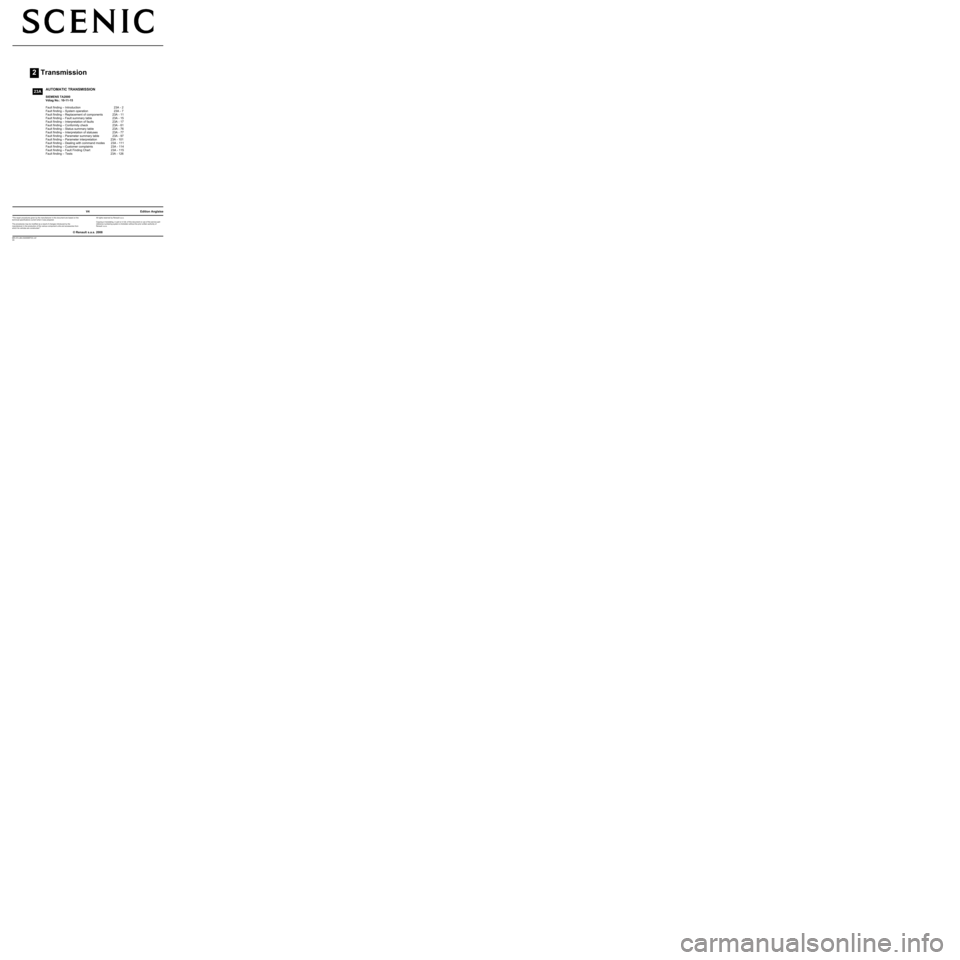
2Transmission
V4 MR-372-J84-23A050$TOC.mif
V4
23A
"The repair procedures given by the manufacturer in this document are based on the
technical specifications current when it was prepared.
The procedures may be modified as a result of changes introduced by the
manufacturer in the production of the various component units and accessories from
which his vehicles are constructed."
V4
All rights reserved by Renault s.a.s.
Edition Anglaise
Copying or translating, in part or in full, of this document or use of the service part
reference numbering system is forbidden without the prior written authority of
Renault s.a.s.
© Renault s.a.s. 2008
AUTOMATIC TRANSMISSION
SIEMENS TA2000
Vdiag No.: 10-11-15
Fault finding – Introduction 23A - 2
Fault finding – System operation 23A - 7
Fault finding – Replacement of components 23A - 11
Fault finding – Fault summary table 23A - 15
Fault finding – Interpretation of faults 23A - 17
Fault finding – Conformity check 23A - 61
Fault finding – Status summary table 23A - 76
Fault finding – Interpretation of statuses 23A - 77
Fault finding – Parameter summary table 23A - 97
Fault finding – Parameter interpretation 23A - 101
Fault finding – Dealing with command modes 23A - 111
Fault finding – Customer complaints 23A - 114
Fault finding – Fault Finding Chart 23A - 115
Fault finding – Tests 23A - 126
Page 2 of 128
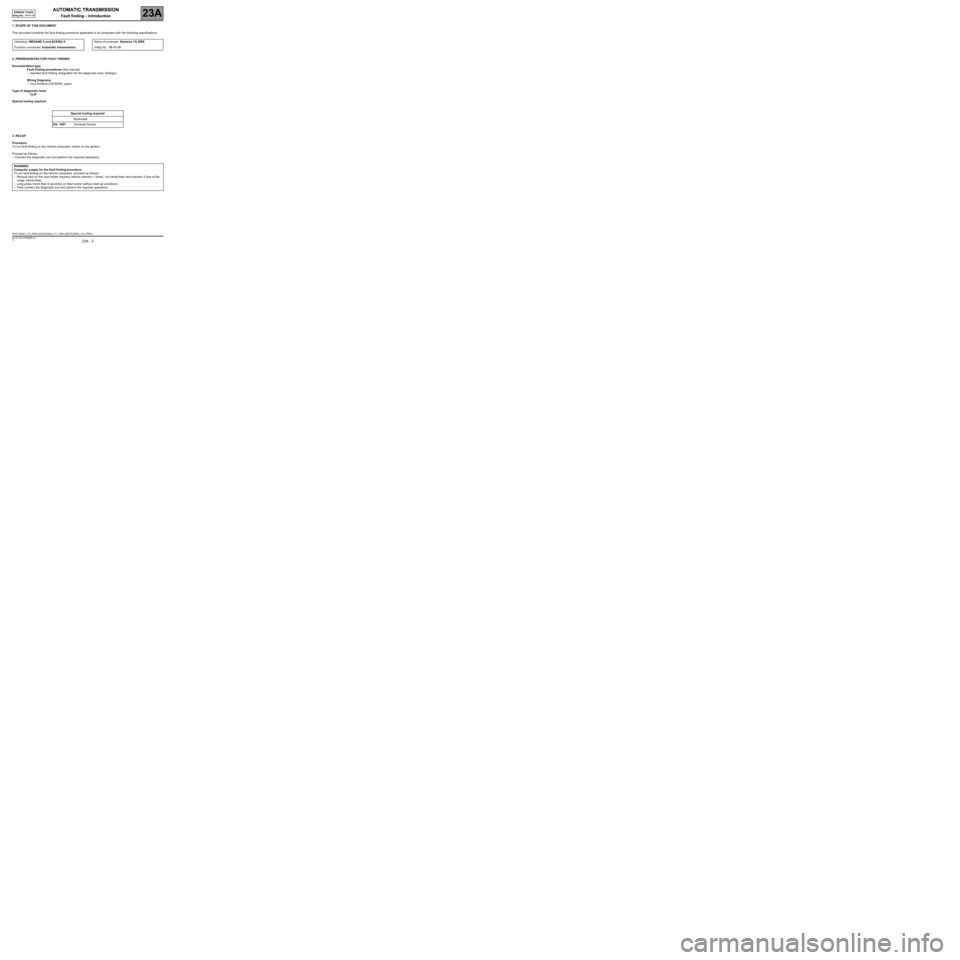
AUTOMATIC TRANSMISSION
Fault finding – Introduction23A
23A - 2V4 MR-372-J84-23A050$066.mif
123A
SIEMENS TA2000
Vdiag No.: 10-11-15AUTOMATIC TRANSMISSION
Fault finding – Introduction
1. SCOPE OF THIS DOCUMENT
This document presents the fault finding procedure applicable to all computers with the following specifications:
2. PREREQUISITES FOR FAULT FINDING
Documentation type
Fault finding procedures (this manual):
–Assisted fault finding (integrated into the diagnostic tool), Dialogys.
Wiring Diagrams:
–Visu-Schéma (CD-ROM), paper.
Type of diagnostic tools
–CLIP
Special tooling required
3. RECAP
Procedure
To run fault finding on the vehicle computers, switch on the ignition.
Proceed as follows:
–Connect the diagnostic tool and perform the required operations. Vehicle(s): MEGANE II and SCENIC II
Function concerned: Automatic transmissionName of computer: Siemens TA 2000
Vdiag No.: 10-11-15
Special tooling required
Multimeter
Elé. 1681Universal bornier
WARNING
Computer supply for the fault finding procedure:
To run fault finding on the vehicle computers, proceed as follows:
–Renault card on the card holder (keyless vehicle scenario 1 (basic, not hands-free) and scenario 2 (top of the
range, hands-free)
–Long press (more than 5 seconds) on Start button without start-up conditions
–Then connect the diagnostic tool and perform the required operations.
DP0TA2000_V10_PRELI/DP0TA2000_V11_PRELI/DP0TA2000_V15_PRELI
MR-372-J84-23A050$066.mif
Page 3 of 128
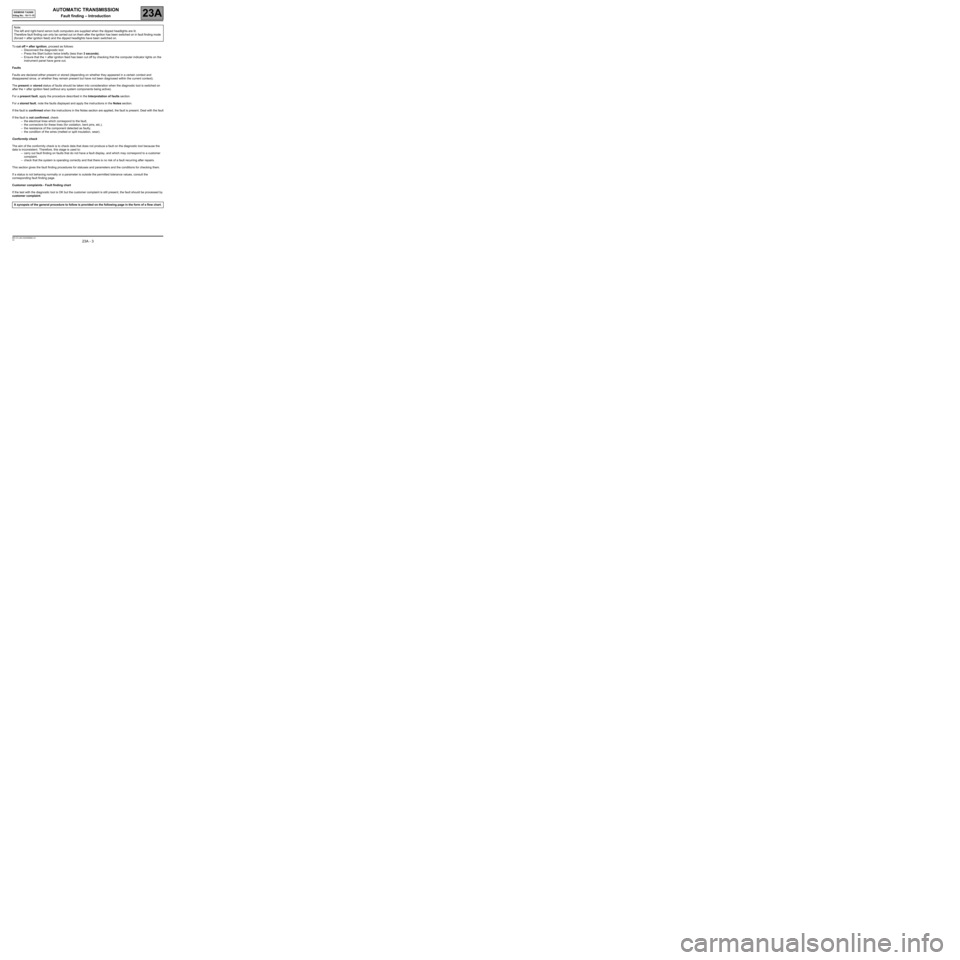
AUTOMATIC TRANSMISSION
Fault finding – Introduction23A
23A - 3V4 MR-372-J84-23A050$066.mif
SIEMENS TA2000
Vdiag No.: 10-11-15
To cut off + after ignition, proceed as follows:
–Disconnect the diagnostic tool.
–Press the Start button twice briefly (less than 3 seconds).
–Ensure that the + after ignition feed has been cut off by checking that the computer indicator lights on the
instrument panel have gone out.
Faults
Faults are declared either present or stored (depending on whether they appeared in a certain context and
disappeared since, or whether they remain present but have not been diagnosed within the current context).
The present or stored status of faults should be taken into consideration when the diagnostic tool is switched on
after the + after ignition feed (without any system components being active).
For a present fault, apply the procedure described in the Interpretation of faults section.
For a stored fault, note the faults displayed and apply the instructions in the Notes section.
If the fault is confirmed when the instructions in the Notes section are applied, the fault is present. Deal with the fault
If the fault is not confirmed, check:
–the electrical lines which correspond to the fault,
–the connectors for these lines (for oxidation, bent pins, etc.),
–the resistance of the component detected as faulty,
–the condition of the wires (melted or split insulation, wear).
Conformity check
The aim of the conformity check is to check data that does not produce a fault on the diagnostic tool because the
data is inconsistent. Therefore, this stage is used to:
–carry out fault finding on faults that do not have a fault display, and which may correspond to a customer
complaint.
–check that the system is operating correctly and that there is no risk of a fault recurring after repairs.
This section gives the fault finding procedures for statuses and parameters and the conditions for checking them.
If a status is not behaving normally or a parameter is outside the permitted tolerance values, consult the
corresponding fault finding page.
Customer complaints - Fault finding chart
If the test with the diagnostic tool is OK but the customer complaint is still present, the fault should be processed by
customer complaint. Note:
The left and right-hand xenon bulb computers are supplied when the dipped headlights are lit.
Therefore fault finding can only be carried out on them after the ignition has been switched on in fault finding mode
(forced + after ignition feed) and the dipped headlights have been switched on.
A synopsis of the general procedure to follow is provided on the following page in the form of a flow chart.
Page 4 of 128
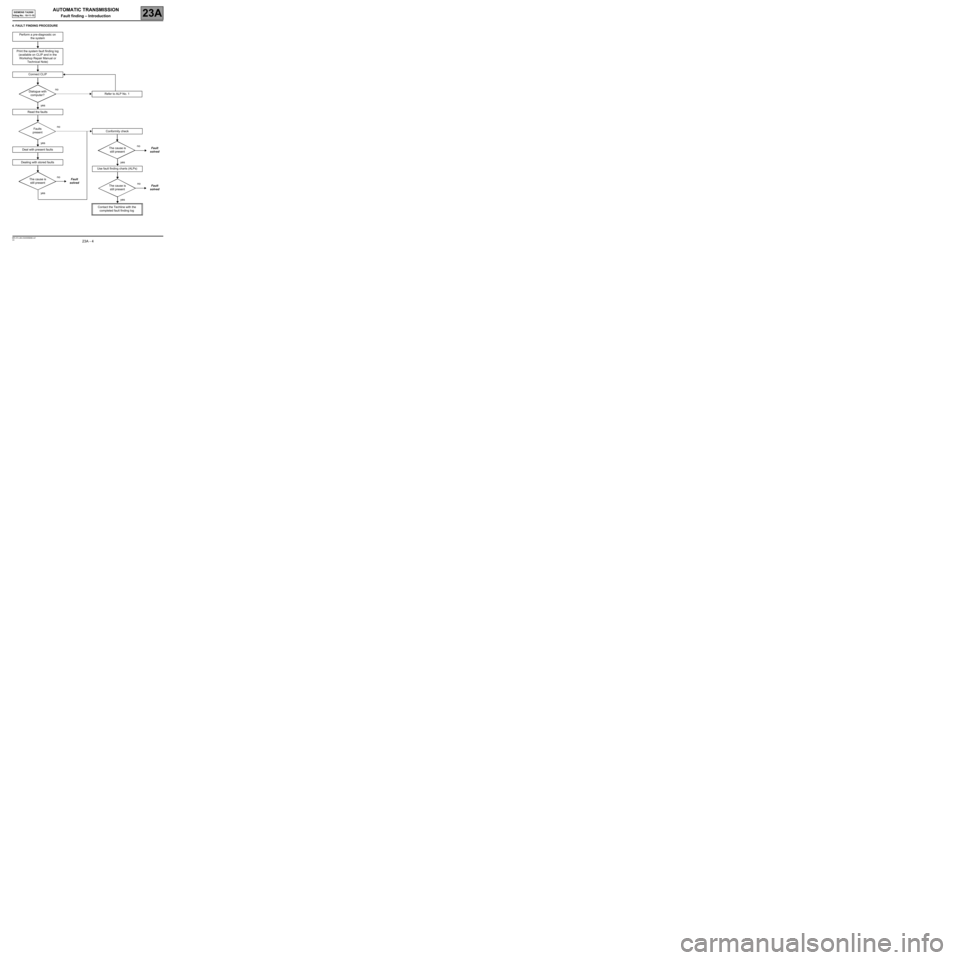
AUTOMATIC TRANSMISSION
Fault finding – Introduction23A
23A - 4V4 MR-372-J84-23A050$066.mif
SIEMENS TA2000
Vdiag No.: 10-11-15
4. FAULT FINDING PROCEDURE
Perform a pre-diagnostic on
the system
Print the system fault finding log
(available on CLIP and in the
Workshop Repair Manual or
Technical Note)
Connect CLIP
no
Dialogue with
computer?
yes
Read the faults
no
Faults
present
yes
Deal with present faults
Dealing with stored faults
no
The cause is
still presentFault
solved
yes
Refer to ALP No. 1
Conformity check
no
The cause is
still presentFault
solved
yes
Use fault finding charts (ALPs)
no
The cause is
still presentFault
solved
yes
Contact the Techline with the
completed fault finding log
Page 5 of 128
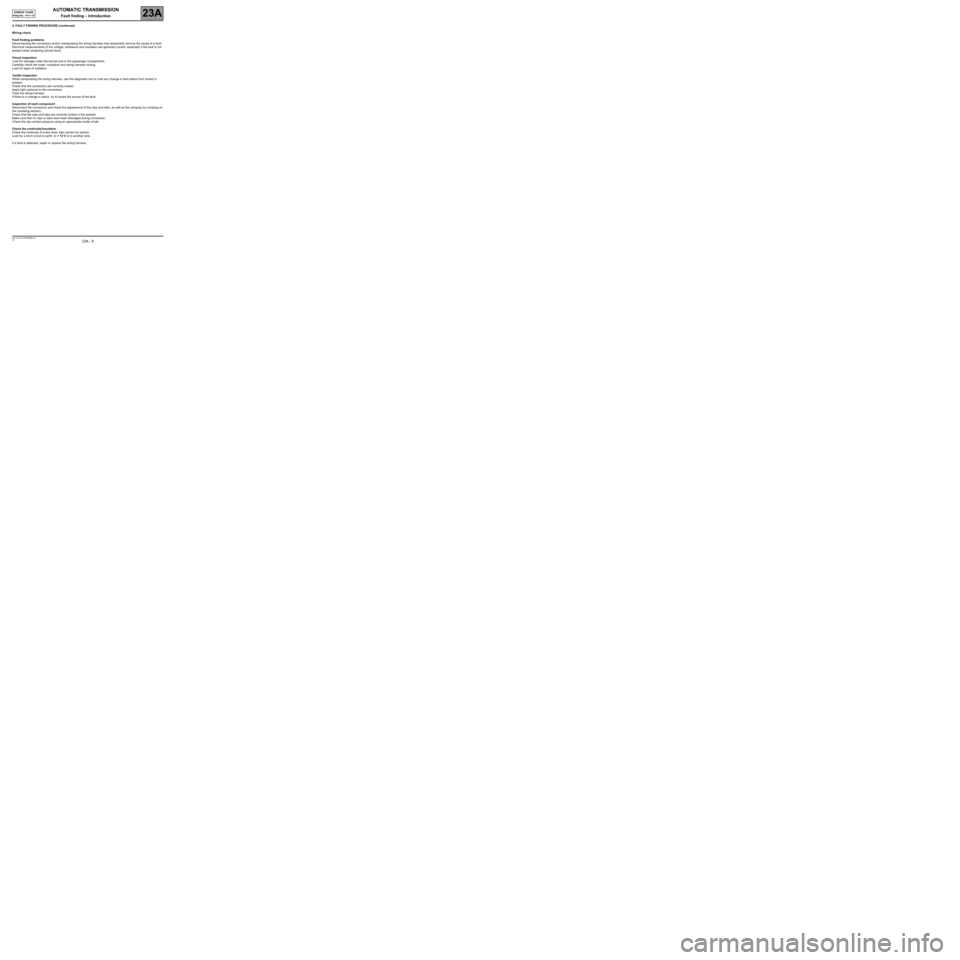
AUTOMATIC TRANSMISSION
Fault finding – Introduction23A
23A - 5V4 MR-372-J84-23A050$066.mif
SIEMENS TA2000
Vdiag No.: 10-11-15
4. FAULT FINDING PROCEDURE (continued)
Wiring check
Fault finding problems
Disconnecting the connectors and/or manipulating the wiring harness may temporarily remove the cause of a fault.
Electrical measurements of the voltage, resistance and insulation are generally correct, especially if the fault is not
present when analysing (stored fault).
Visual inspection
Look for damage under the bonnet and in the passenger compartment.
Carefully check the fuses, insulators and wiring harness routing.
Look for signs of oxidation.
Tactile inspection
While manipulating the wiring harness, use the diagnostic tool to note any change in fault status from stored or
present.
Check that the connectors are correctly locked.
Apply light pressure to the connectors.
Twist the wiring harness.
If there is a change in status, try to locate the source of the fault.
Inspection of each component
Disconnect the connectors and check the appearance of the clips and tabs, as well as the crimping (no crimping on
the insulating section).
Check that the clips and tabs are correctly locked in the sockets.
Make sure that no clips or tabs have been dislodged during connection.
Check the clip contact pressure using an appropriate model of tab.
Check the continuity/insulation
Check the continuity of entire lines, then section by section.
Look for a short circuit to earth, to + 12 V or to another wire.
If a fault is detected, repair or replace the wiring harness.
Page 6 of 128
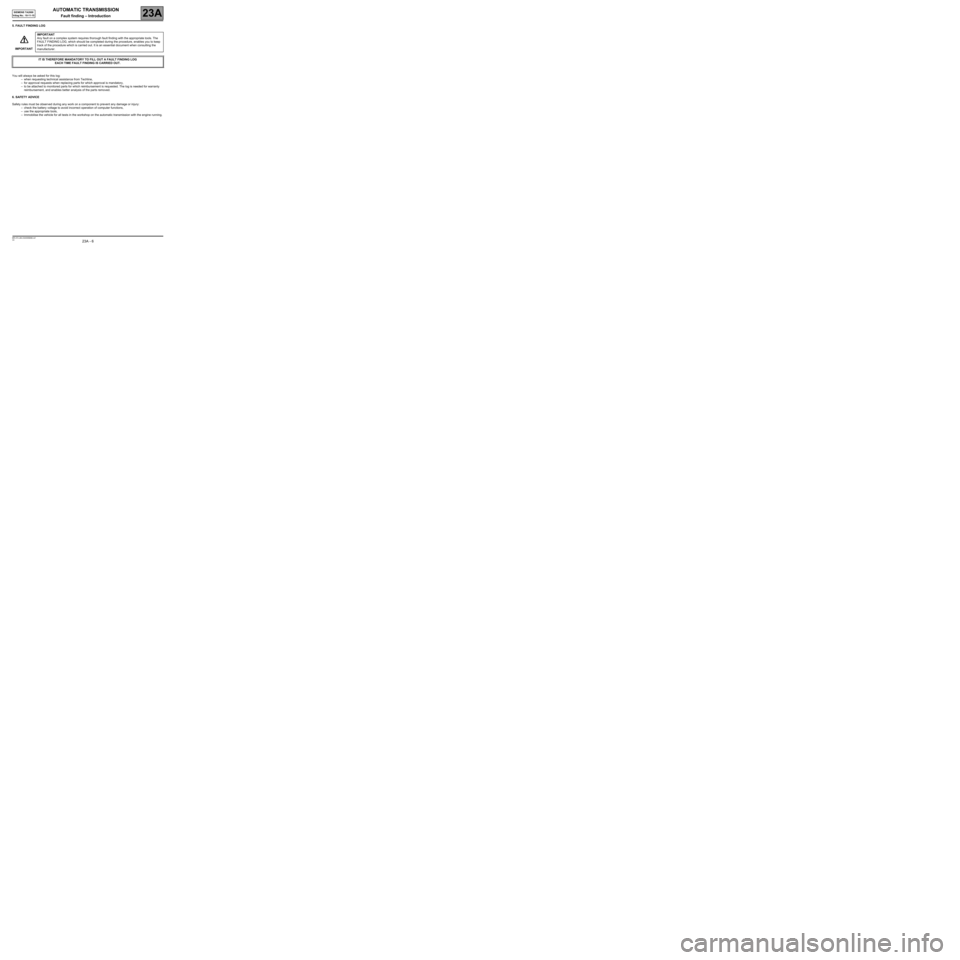
AUTOMATIC TRANSMISSION
Fault finding – Introduction23A
23A - 6V4 MR-372-J84-23A050$066.mif
SIEMENS TA2000
Vdiag No.: 10-11-15
5. FAULT FINDING LOG
You will always be asked for this log:
–when requesting technical assistance from Techline,
–for approval requests when replacing parts for which approval is mandatory,
–to be attached to monitored parts for which reimbursement is requested. The log is needed for warranty
reimbursement, and enables better analysis of the parts removed.
6. SAFETY ADVICE
Safety rules must be observed during any work on a component to prevent any damage or injury:
–check the battery voltage to avoid incorrect operation of computer functions,
–use the appropriate tools,
–Immobilise the vehicle for all tests in the workshop on the automatic transmission with the engine running. IMPORTANTIMPORTANT
Any fault on a complex system requires thorough fault finding with the appropriate tools. The
FAULT FINDING LOG, which should be completed during the procedure, enables you to keep
track of the procedure which is carried out. It is an essential document when consulting the
manufacturer.
IT IS THEREFORE MANDATORY TO FILL OUT A FAULT FINDING LOG
EACH TIME FAULT FINDING IS CARRIED OUT.
Page 7 of 128

AUTOMATIC TRANSMISSION
Fault finding – System operation23A
23A-7V4 MR-372-J84-23A050$132.mif
SIEMENS TA2000
Vdiag No.: 10-11-15AUTOMATIC TRANSMISSION
Fault finding – System operation
GENERAL OPERATION
The automatic transmission on this model is a DP0, which is also found on other Renault vehicles including
the Clio II, Kangoo or Megane.
The automatic transmission computer controls gear-shifting based on several parameters, among them engine
torque and the type of driving adopted by the driver.
All signals travel to the computer by wire, except for those from the injection computer, which use the multiplex
network.
Line K is used for computer diagnostics.
SYSTEM OPERATION
Multifunction switch (CMF) statuses:
Note:
Multifunction switch contact S1 is not connected on this vehicle.
Ignore ET154 Multifunction switches.
Lever positionMultifunction switch contact
P/N S2 S3S4
POPEN OPEN CLOSED CLOSED
ROPEN OPEN OPEN OPEN
NCLOSED CLOSED OPEN CLOSED
DCLOSED CLOSED CLOSED OPEN
MCLOSED CLOSED CLOSED OPEN
+CLOSED CLOSED CLOSED OPEN
-CLOSED CLOSED CLOSED OPEN
MR-372-J84-23A050$132.mif
Page 8 of 128
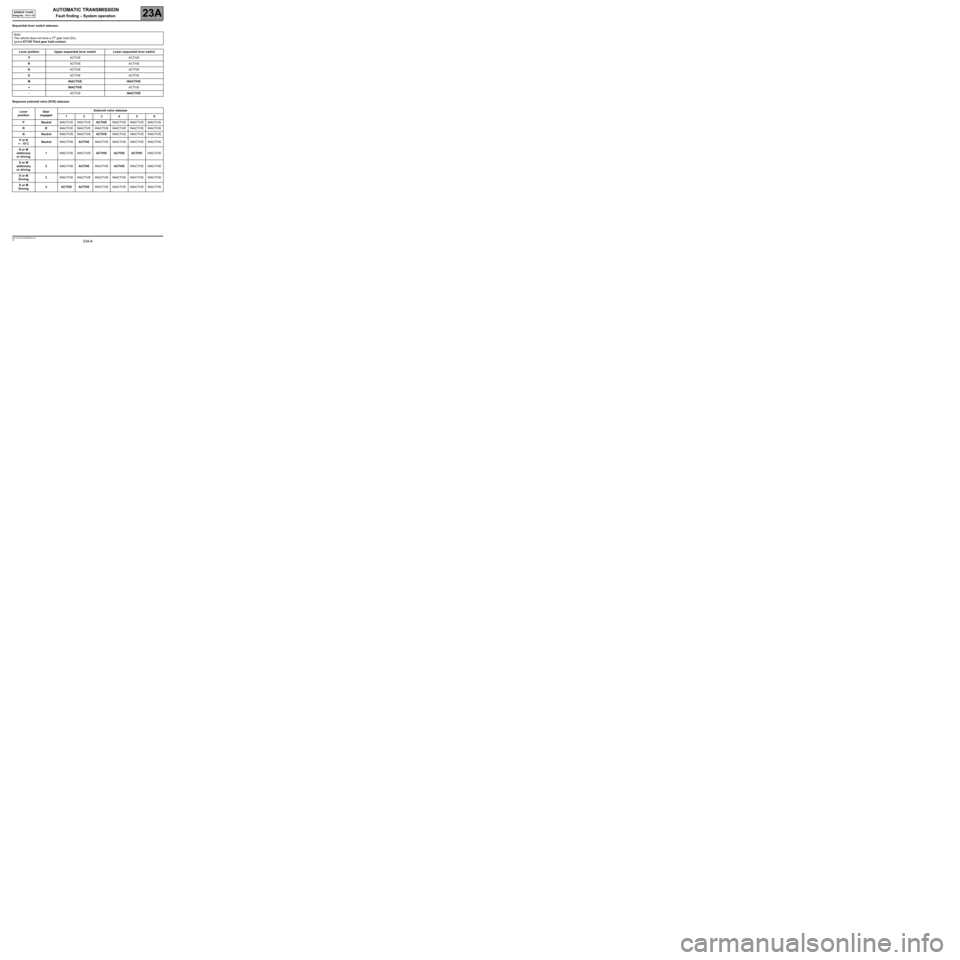
AUTOMATIC TRANSMISSION
Fault finding – System operation23A
23A-8V4 MR-372-J84-23A050$132.mif
SIEMENS TA2000
Vdiag No.: 10-11-15
Sequential lever switch statuses:
Sequence solenoid valve (EVS) statuses:Note:
The vehicle does not have a 3
rd gear hold (D3).
Ignore ET155 Third gear hold contact.
Lever position Upper sequential lever switch Lower sequential lever switch
PACTIVE ACTIVE
RACTIVE ACTIVE
NACTIVE ACTIVE
DACTIVE ACTIVE
MINACTIVE INACTIVE
+INACTIVEACTIVE
-ACTIVEINACTIVE
Lever
positionGear
engaged Solenoid valve statuses
1234 56
PNeutralINACTIVE INACTIVEACTIVEINACTIVE INACTIVE INACTIVE
RRINACTIVE INACTIVE INACTIVE INACTIVE INACTIVE INACTIVE
NNeutralINACTIVE INACTIVEACTIVEINACTIVE INACTIVE INACTIVE
P or N
< - 10˚CNeutralINACTIVEACTIVEINACTIVE INACTIVE INACTIVE INACTIVE
D or M
stationary
or driving1INACTIVE INACTIVEACTIVE ACTIVE ACTIVEINACTIVE
D or M
stationary
or driving2INACTIVEACTIVEINACTIVEACTIVEINACTIVE INACTIVE
D or M
Driving3INACTIVE INACTIVE INACTIVE INACTIVE INACTIVE INACTIVE
D or M
Driving4ACTIVE ACTIVEINACTIVE INACTIVE INACTIVE INACTIVE
Page 9 of 128
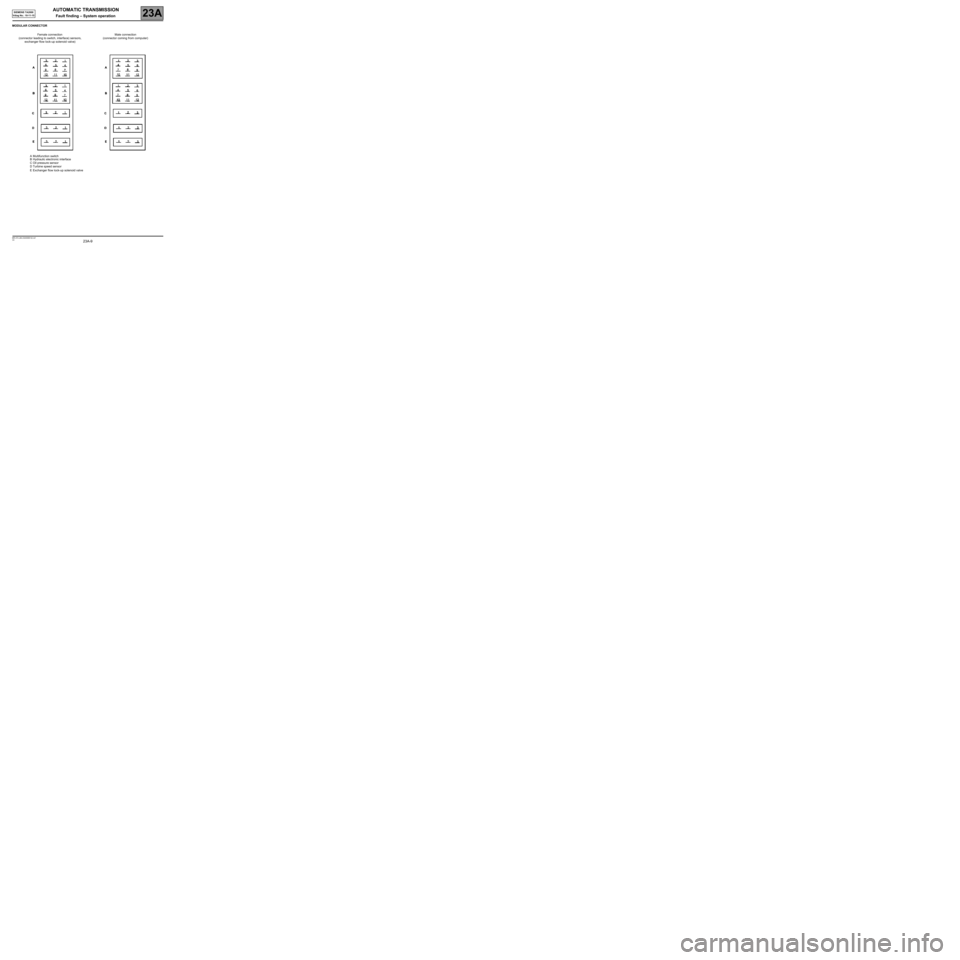
AUTOMATIC TRANSMISSION
Fault finding – System operation23A
23A-9V4 MR-372-J84-23A050$132.mif
SIEMENS TA2000
Vdiag No.: 10-11-15
MODULAR CONNECTOR
AMultifunction switch
BHydraulic electronic interface
COil pressure sensor
DTurbine speed sensor
EExchanger flow lock-up solenoid valveFemale connection
(connector leading to switch, interface) sensors,
exchanger flow lock-up solenoid valve)Male connection
(connector coming from computer)
Page 10 of 128
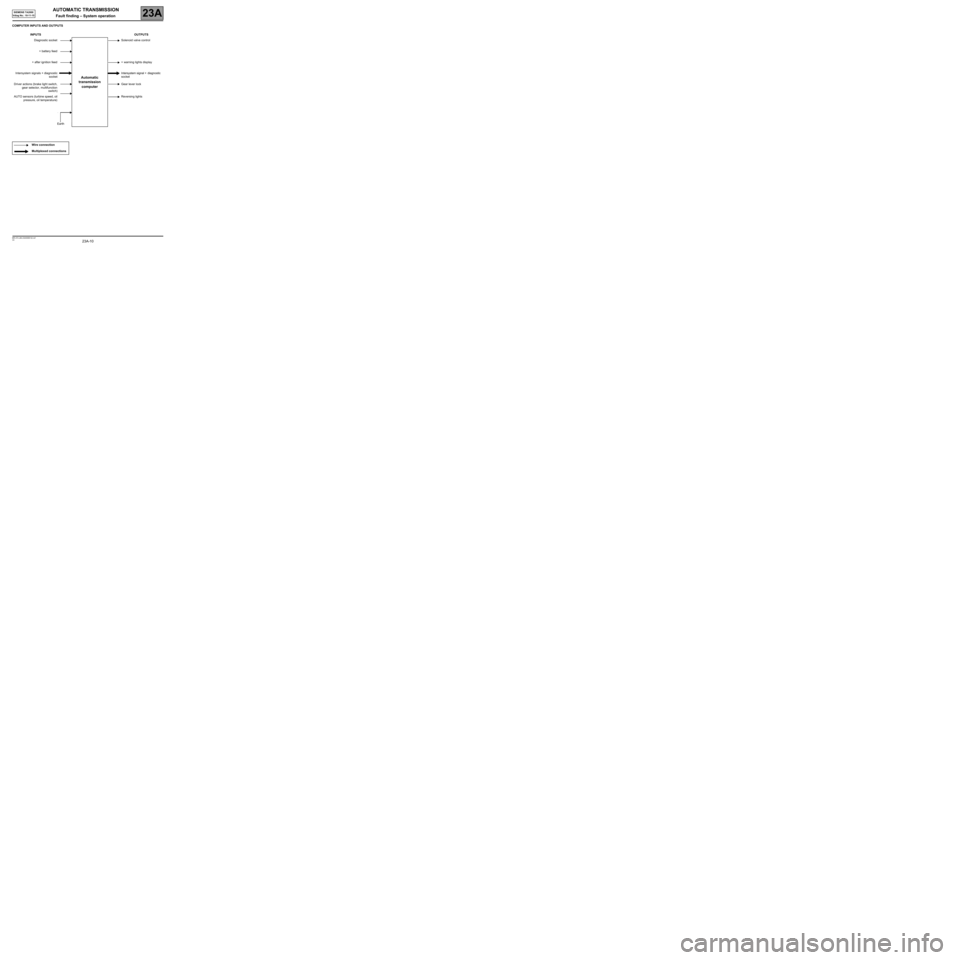
AUTOMATIC TRANSMISSION
Fault finding – System operation23A
23A-10V4 MR-372-J84-23A050$132.mif
SIEMENS TA2000
Vdiag No.: 10-11-15
COMPUTER INPUTS AND OUTPUTS
INPUTS OUTPUTS
Diagnostic socket
Automatic
transmission
computer
Solenoid valve control
+ battery feed
+ after ignition feed + warning lights display
Intersystem signals + diagnostic
socketIntersystem signal + diagnostic
socket
Driver actions (brake light switch,
gear selector, multifunction
switch)Gear lever lock
AUTO sensors (turbine speed, oil
pressure, oil temperature)Reversing lights
Earth
Wire connection
Multiplexed connections